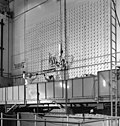Wikipedia:Today's featured article/June 2, 2018
The X-10 Graphite Reactor at Oak Ridge National Laboratory in the U.S. state of Tennessee was the world's second artificial nuclear reactor (after Chicago Pile-1), and the first designed for continuous operation. It was built during World War II as part of the Manhattan Project. The production of sufficient plutonium for atomic bombs required reactors a thousand times as powerful as Chicago Pile-1, along with facilities to chemically separate the plutonium bred in the reactors from uranium and fission products. The air-cooled X-10 pilot plant used nuclear graphite as a neutron moderator and pure natural uranium in metal form for fuel. DuPont commenced construction in Oak Ridge in 1943, and the reactor produced its first plutonium in early 1944. It supplied the Los Alamos Laboratory with its first significant amounts of plutonium, and its first reactor-bred product. The reactor and chemical separation plant provided invaluable experience for engineers, technicians, reactor operators, and safety officials, who then moved on to a larger site in Hanford, Washington. (Full article...)

